ACC621 Assignment: Analyzing Technology in Audit Engagements
VerifiedAdded on 2022/10/18
|11
|2210
|286
Report
AI Summary
This report examines the increasing role of technology in auditing practices, addressing concerns about auditor redundancy due to technological advancements. It discusses the impact of digitalization and information technology on audit processes, highlighting factors such as increased data availability, lower device costs, and innovation. The report focuses on three major technologies: data analytics, artificial intelligence, and robotic process automation, and their potential to disrupt traditional auditing procedures. It emphasizes the benefits of data analytics in reducing data storage costs, improving algorithm efficiency, and enhancing data analysis and presentation. While technology enhances risk assessment and decision-making, the report asserts that auditors remain crucial for stakeholder relations and interpreting technological findings. The report concludes by recommending the adoption of data analytics for a small audit firm, enabling better auditing plans, risk identification, and cost-effectiveness. This document is available on Desklib, where students can find a variety of past papers and solved assignments.
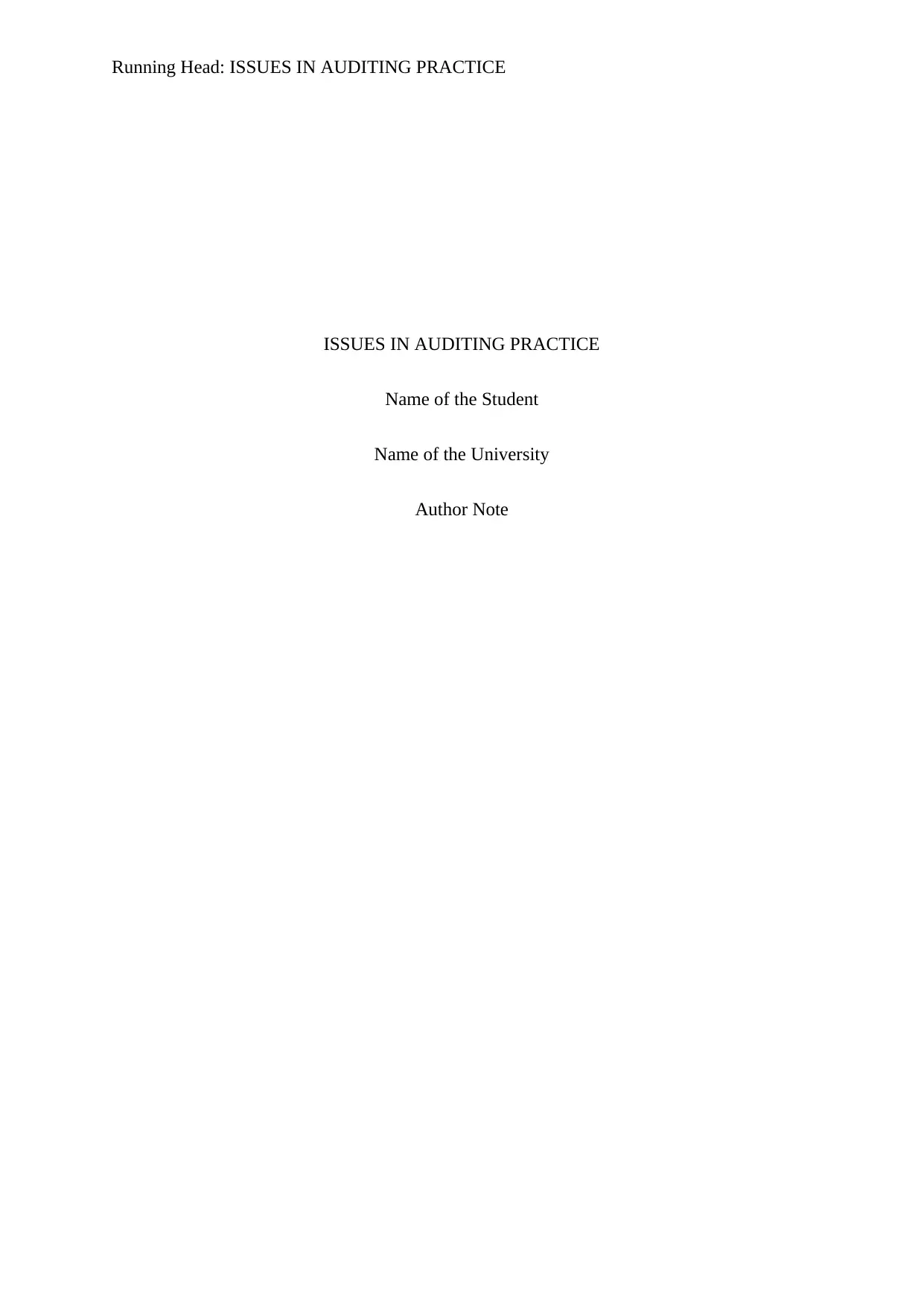
Running Head: ISSUES IN AUDITING PRACTICE
ISSUES IN AUDITING PRACTICE
Name of the Student
Name of the University
Author Note
ISSUES IN AUDITING PRACTICE
Name of the Student
Name of the University
Author Note
Paraphrase This Document
Need a fresh take? Get an instant paraphrase of this document with our AI Paraphraser

1ISSUES IN AUDITING PRACTICE
Table of Contents
Email Draft.................................................................................................................................2
Evidence in Support of Comments made in Email....................................................................4
Reference....................................................................................................................................8
Table of Contents
Email Draft.................................................................................................................................2
Evidence in Support of Comments made in Email....................................................................4
Reference....................................................................................................................................8
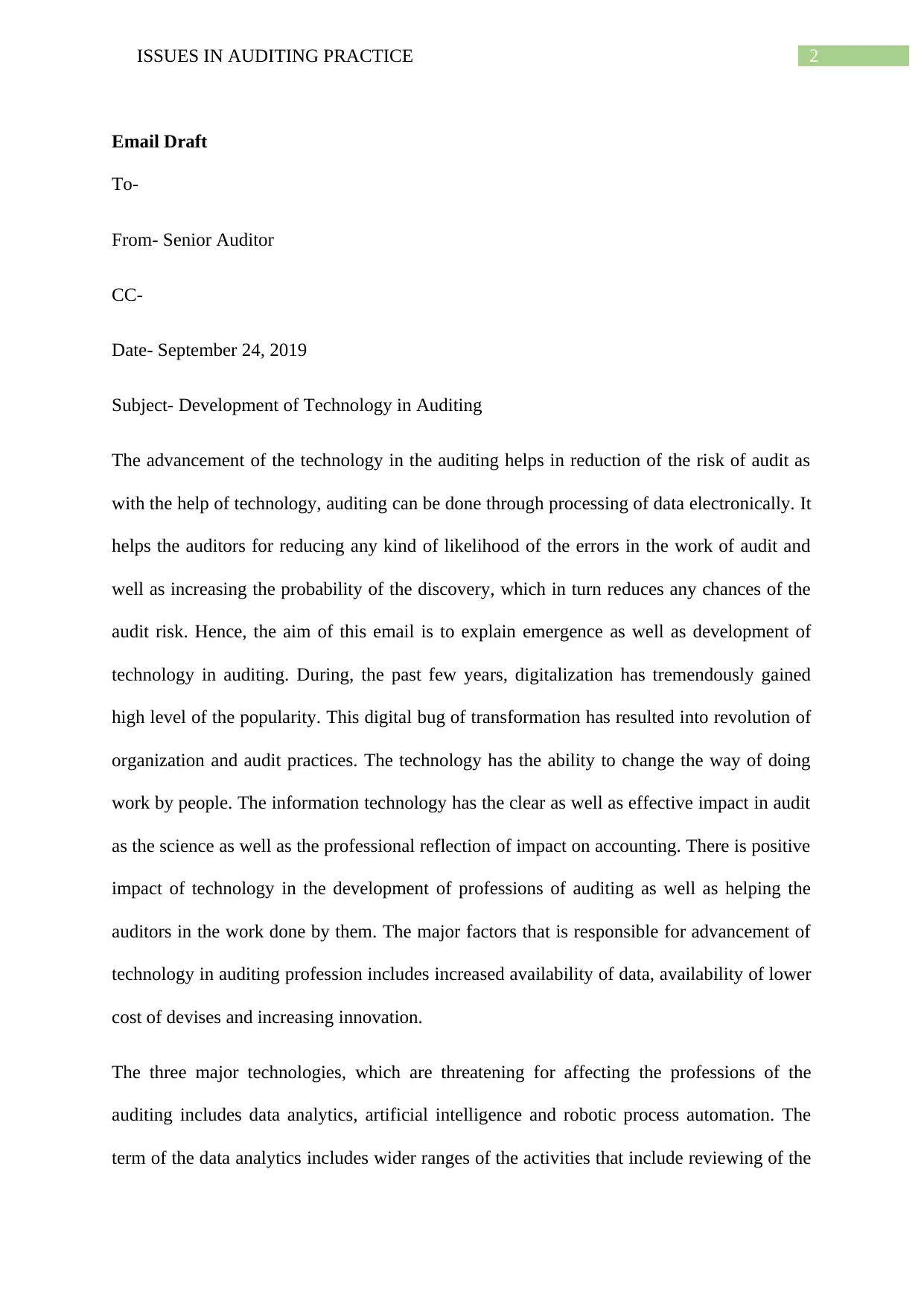
2ISSUES IN AUDITING PRACTICE
Email Draft
To-
From- Senior Auditor
CC-
Date- September 24, 2019
Subject- Development of Technology in Auditing
The advancement of the technology in the auditing helps in reduction of the risk of audit as
with the help of technology, auditing can be done through processing of data electronically. It
helps the auditors for reducing any kind of likelihood of the errors in the work of audit and
well as increasing the probability of the discovery, which in turn reduces any chances of the
audit risk. Hence, the aim of this email is to explain emergence as well as development of
technology in auditing. During, the past few years, digitalization has tremendously gained
high level of the popularity. This digital bug of transformation has resulted into revolution of
organization and audit practices. The technology has the ability to change the way of doing
work by people. The information technology has the clear as well as effective impact in audit
as the science as well as the professional reflection of impact on accounting. There is positive
impact of technology in the development of professions of auditing as well as helping the
auditors in the work done by them. The major factors that is responsible for advancement of
technology in auditing profession includes increased availability of data, availability of lower
cost of devises and increasing innovation.
The three major technologies, which are threatening for affecting the professions of the
auditing includes data analytics, artificial intelligence and robotic process automation. The
term of the data analytics includes wider ranges of the activities that include reviewing of the
Email Draft
To-
From- Senior Auditor
CC-
Date- September 24, 2019
Subject- Development of Technology in Auditing
The advancement of the technology in the auditing helps in reduction of the risk of audit as
with the help of technology, auditing can be done through processing of data electronically. It
helps the auditors for reducing any kind of likelihood of the errors in the work of audit and
well as increasing the probability of the discovery, which in turn reduces any chances of the
audit risk. Hence, the aim of this email is to explain emergence as well as development of
technology in auditing. During, the past few years, digitalization has tremendously gained
high level of the popularity. This digital bug of transformation has resulted into revolution of
organization and audit practices. The technology has the ability to change the way of doing
work by people. The information technology has the clear as well as effective impact in audit
as the science as well as the professional reflection of impact on accounting. There is positive
impact of technology in the development of professions of auditing as well as helping the
auditors in the work done by them. The major factors that is responsible for advancement of
technology in auditing profession includes increased availability of data, availability of lower
cost of devises and increasing innovation.
The three major technologies, which are threatening for affecting the professions of the
auditing includes data analytics, artificial intelligence and robotic process automation. The
term of the data analytics includes wider ranges of the activities that include reviewing of the
⊘ This is a preview!⊘
Do you want full access?
Subscribe today to unlock all pages.

Trusted by 1+ million students worldwide
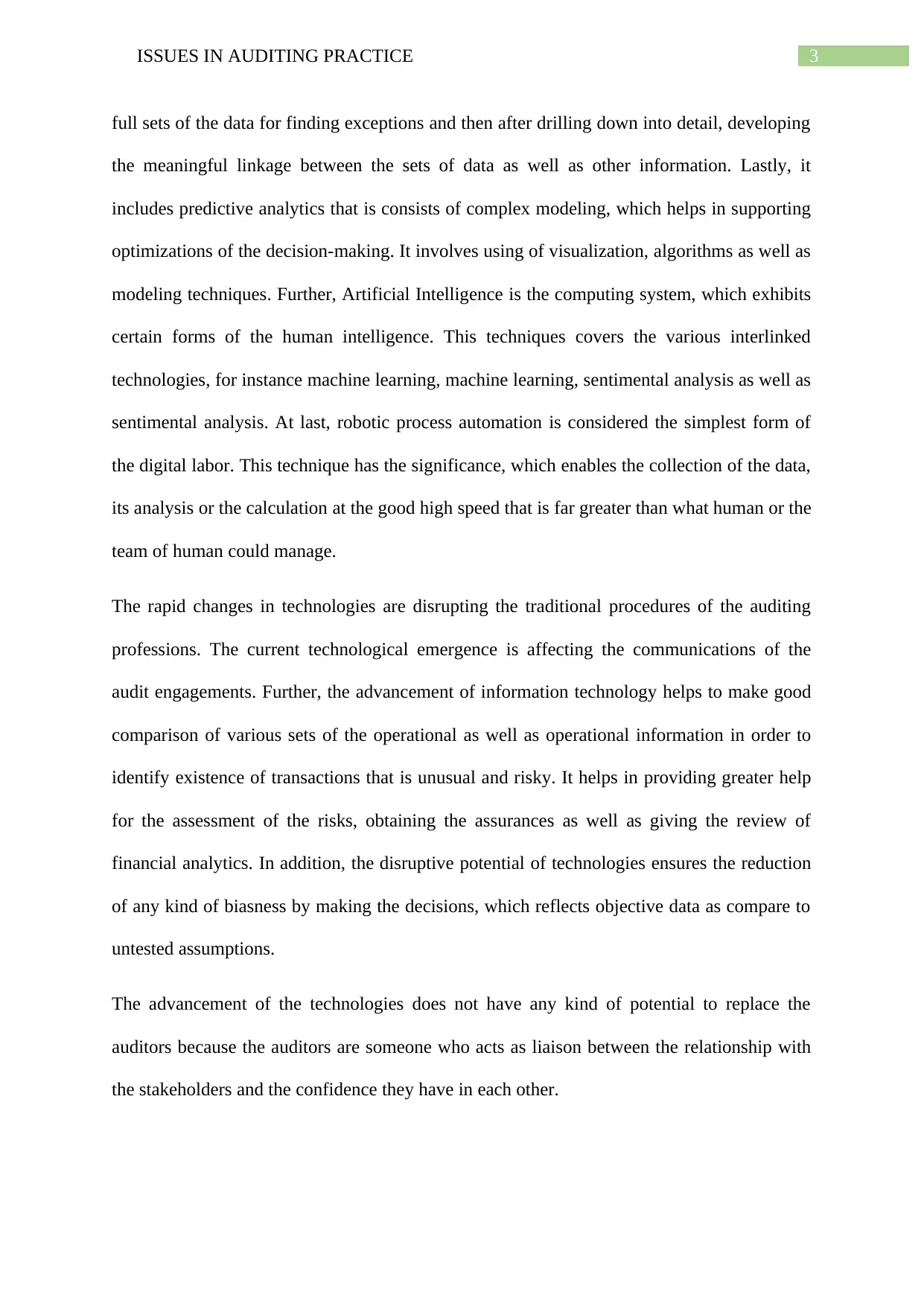
3ISSUES IN AUDITING PRACTICE
full sets of the data for finding exceptions and then after drilling down into detail, developing
the meaningful linkage between the sets of data as well as other information. Lastly, it
includes predictive analytics that is consists of complex modeling, which helps in supporting
optimizations of the decision-making. It involves using of visualization, algorithms as well as
modeling techniques. Further, Artificial Intelligence is the computing system, which exhibits
certain forms of the human intelligence. This techniques covers the various interlinked
technologies, for instance machine learning, machine learning, sentimental analysis as well as
sentimental analysis. At last, robotic process automation is considered the simplest form of
the digital labor. This technique has the significance, which enables the collection of the data,
its analysis or the calculation at the good high speed that is far greater than what human or the
team of human could manage.
The rapid changes in technologies are disrupting the traditional procedures of the auditing
professions. The current technological emergence is affecting the communications of the
audit engagements. Further, the advancement of information technology helps to make good
comparison of various sets of the operational as well as operational information in order to
identify existence of transactions that is unusual and risky. It helps in providing greater help
for the assessment of the risks, obtaining the assurances as well as giving the review of
financial analytics. In addition, the disruptive potential of technologies ensures the reduction
of any kind of biasness by making the decisions, which reflects objective data as compare to
untested assumptions.
The advancement of the technologies does not have any kind of potential to replace the
auditors because the auditors are someone who acts as liaison between the relationship with
the stakeholders and the confidence they have in each other.
full sets of the data for finding exceptions and then after drilling down into detail, developing
the meaningful linkage between the sets of data as well as other information. Lastly, it
includes predictive analytics that is consists of complex modeling, which helps in supporting
optimizations of the decision-making. It involves using of visualization, algorithms as well as
modeling techniques. Further, Artificial Intelligence is the computing system, which exhibits
certain forms of the human intelligence. This techniques covers the various interlinked
technologies, for instance machine learning, machine learning, sentimental analysis as well as
sentimental analysis. At last, robotic process automation is considered the simplest form of
the digital labor. This technique has the significance, which enables the collection of the data,
its analysis or the calculation at the good high speed that is far greater than what human or the
team of human could manage.
The rapid changes in technologies are disrupting the traditional procedures of the auditing
professions. The current technological emergence is affecting the communications of the
audit engagements. Further, the advancement of information technology helps to make good
comparison of various sets of the operational as well as operational information in order to
identify existence of transactions that is unusual and risky. It helps in providing greater help
for the assessment of the risks, obtaining the assurances as well as giving the review of
financial analytics. In addition, the disruptive potential of technologies ensures the reduction
of any kind of biasness by making the decisions, which reflects objective data as compare to
untested assumptions.
The advancement of the technologies does not have any kind of potential to replace the
auditors because the auditors are someone who acts as liaison between the relationship with
the stakeholders and the confidence they have in each other.
Paraphrase This Document
Need a fresh take? Get an instant paraphrase of this document with our AI Paraphraser

4ISSUES IN AUDITING PRACTICE
The technologies that would be most appropriate for this firm is adoption and implementation
of data analytics. It is traditional techniques used by this company are no longer effective in
providing solutions for the issues faced by the companies. Hence, data analytics will help in
reducing the cost of the data storage, efficient algorithm as well as better software, which
makes analysis, retrieval as well as its higher quality presentations much faster and cheaper
than before.
I, therefore, hope that this particular draft of mail will be of great use in developing the
understanding relating to replacement of the traditional techniques and installment of the
technology in the company.
Kind Regards,
XYZ
Evidence in Support of Comments made in Email
When the profession of the audit practices is integrated with the information
technology then risks of the business can be detected more easily. The technology
advancement enhances the auditing practices. The traditional audit method is no more enough
and competent in detection of risks and giving the authentic result. Hence, information
technology is playing key role in supporting the judgments of the auditors and enhancing the
quality of the audit (Chou 2015).
The changing business environment and emerging of the scandals is demanding for
the more advanced version of the auditing practices. The technology is used by the audit
professionals for doing the tasks in much better way and with higher level of precision. In
this respect, cloud computing and cloud storage has opened new possibilities for collection
and analyzing the data on prior unimaginable scale (Bierstaker, Janvrin and Lowe 2014). The
technological advancement is changing drastically the operations of the business and it is
The technologies that would be most appropriate for this firm is adoption and implementation
of data analytics. It is traditional techniques used by this company are no longer effective in
providing solutions for the issues faced by the companies. Hence, data analytics will help in
reducing the cost of the data storage, efficient algorithm as well as better software, which
makes analysis, retrieval as well as its higher quality presentations much faster and cheaper
than before.
I, therefore, hope that this particular draft of mail will be of great use in developing the
understanding relating to replacement of the traditional techniques and installment of the
technology in the company.
Kind Regards,
XYZ
Evidence in Support of Comments made in Email
When the profession of the audit practices is integrated with the information
technology then risks of the business can be detected more easily. The technology
advancement enhances the auditing practices. The traditional audit method is no more enough
and competent in detection of risks and giving the authentic result. Hence, information
technology is playing key role in supporting the judgments of the auditors and enhancing the
quality of the audit (Chou 2015).
The changing business environment and emerging of the scandals is demanding for
the more advanced version of the auditing practices. The technology is used by the audit
professionals for doing the tasks in much better way and with higher level of precision. In
this respect, cloud computing and cloud storage has opened new possibilities for collection
and analyzing the data on prior unimaginable scale (Bierstaker, Janvrin and Lowe 2014). The
technological advancement is changing drastically the operations of the business and it is
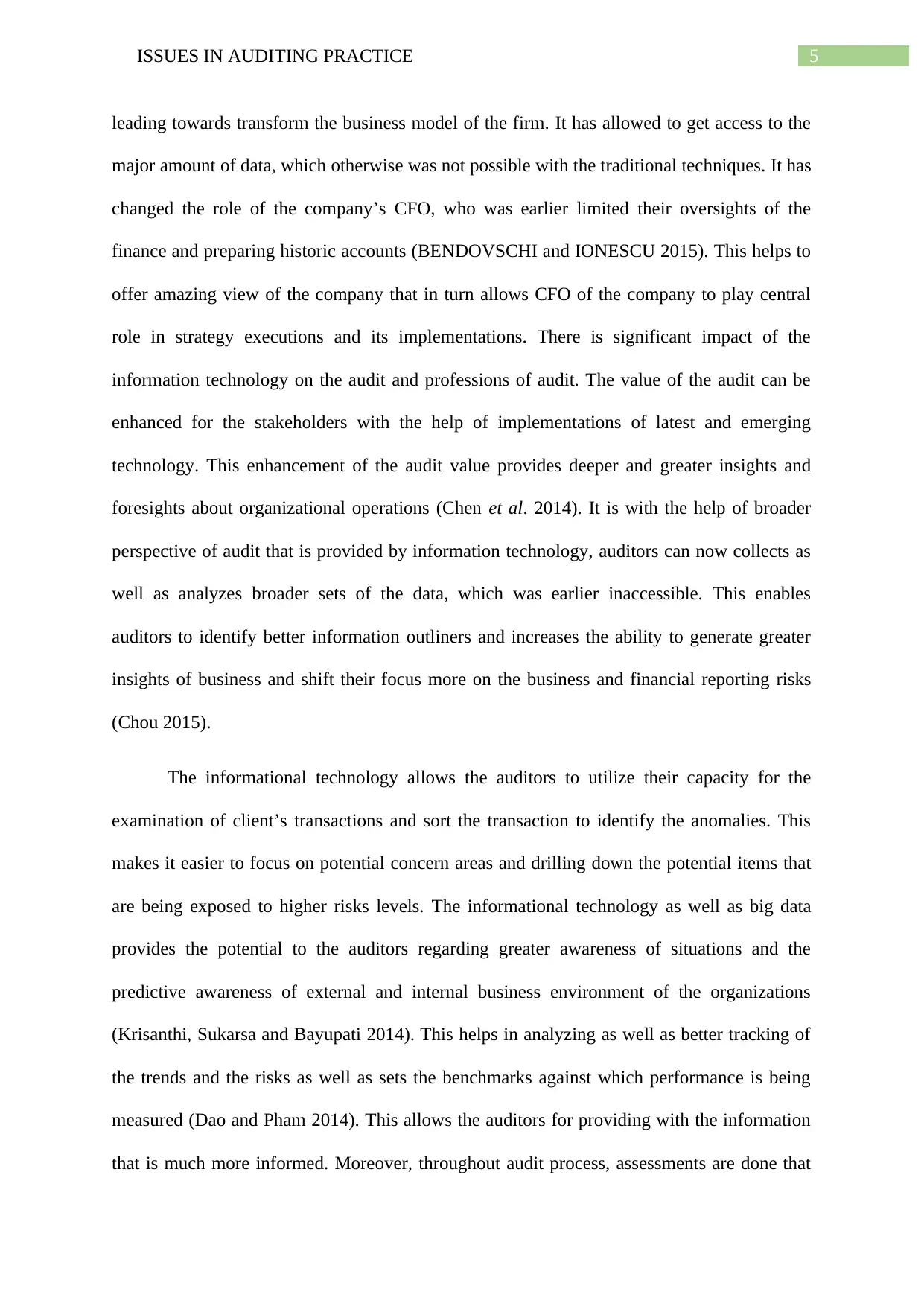
5ISSUES IN AUDITING PRACTICE
leading towards transform the business model of the firm. It has allowed to get access to the
major amount of data, which otherwise was not possible with the traditional techniques. It has
changed the role of the company’s CFO, who was earlier limited their oversights of the
finance and preparing historic accounts (BENDOVSCHI and IONESCU 2015). This helps to
offer amazing view of the company that in turn allows CFO of the company to play central
role in strategy executions and its implementations. There is significant impact of the
information technology on the audit and professions of audit. The value of the audit can be
enhanced for the stakeholders with the help of implementations of latest and emerging
technology. This enhancement of the audit value provides deeper and greater insights and
foresights about organizational operations (Chen et al. 2014). It is with the help of broader
perspective of audit that is provided by information technology, auditors can now collects as
well as analyzes broader sets of the data, which was earlier inaccessible. This enables
auditors to identify better information outliners and increases the ability to generate greater
insights of business and shift their focus more on the business and financial reporting risks
(Chou 2015).
The informational technology allows the auditors to utilize their capacity for the
examination of client’s transactions and sort the transaction to identify the anomalies. This
makes it easier to focus on potential concern areas and drilling down the potential items that
are being exposed to higher risks levels. The informational technology as well as big data
provides the potential to the auditors regarding greater awareness of situations and the
predictive awareness of external and internal business environment of the organizations
(Krisanthi, Sukarsa and Bayupati 2014). This helps in analyzing as well as better tracking of
the trends and the risks as well as sets the benchmarks against which performance is being
measured (Dao and Pham 2014). This allows the auditors for providing with the information
that is much more informed. Moreover, throughout audit process, assessments are done that
leading towards transform the business model of the firm. It has allowed to get access to the
major amount of data, which otherwise was not possible with the traditional techniques. It has
changed the role of the company’s CFO, who was earlier limited their oversights of the
finance and preparing historic accounts (BENDOVSCHI and IONESCU 2015). This helps to
offer amazing view of the company that in turn allows CFO of the company to play central
role in strategy executions and its implementations. There is significant impact of the
information technology on the audit and professions of audit. The value of the audit can be
enhanced for the stakeholders with the help of implementations of latest and emerging
technology. This enhancement of the audit value provides deeper and greater insights and
foresights about organizational operations (Chen et al. 2014). It is with the help of broader
perspective of audit that is provided by information technology, auditors can now collects as
well as analyzes broader sets of the data, which was earlier inaccessible. This enables
auditors to identify better information outliners and increases the ability to generate greater
insights of business and shift their focus more on the business and financial reporting risks
(Chou 2015).
The informational technology allows the auditors to utilize their capacity for the
examination of client’s transactions and sort the transaction to identify the anomalies. This
makes it easier to focus on potential concern areas and drilling down the potential items that
are being exposed to higher risks levels. The informational technology as well as big data
provides the potential to the auditors regarding greater awareness of situations and the
predictive awareness of external and internal business environment of the organizations
(Krisanthi, Sukarsa and Bayupati 2014). This helps in analyzing as well as better tracking of
the trends and the risks as well as sets the benchmarks against which performance is being
measured (Dao and Pham 2014). This allows the auditors for providing with the information
that is much more informed. Moreover, throughout audit process, assessments are done that
⊘ This is a preview!⊘
Do you want full access?
Subscribe today to unlock all pages.

Trusted by 1+ million students worldwide

6ISSUES IN AUDITING PRACTICE
helps in enhancing value of audit for overall investors as well as organizations. The
emergence of the disruptive technologies, for instance data analytics, artificial intelligence
and the robotic process automation has resulted towards greater efforts for reshaping the
existing models of business as well as facilitate the new one. It is because of the emergence
of the new technologies, the repetitive and mundane tasks are becoming less vital (Lombardi,
Bloch and Vasarhelyi 2014).
The use of informational technologies in the auditing profession helps to determine
the essential data and locate the risks attached with it. However, information technology in
auditing is not solely important rather informational technology in liaison with the auditors
will be able to provide better results (Appelbaum, Kogan and Vasarhelyi 2017). It is because
technology can help in determining facts and figures but it is with the interpretation of
auditor, one could know what are the problem areas, where are major risks and possible ways
to mitigate the risks and much more. Therefore, both information technology as well as
auditors plays vital role in providing reliable and relevant information that can be of great use
to the users (Omoteso 2016).
The traditional approaches of the auditing practice are based on just identification as
well as reporting of the significant risky areas. However, with the emergence of use of
technology in the auditing profession has changed the existing scenario of auditing practice
completely (A. Vasarhelyi and Romero 2014). It has brought greater scope in the auditing
profession with the help of simplifying the hectic work load as complexity in the calculations.
Moreover, this advancement has also given scope to the auditors for detecting the risk
involved in the transactions and provides greater level of reliability with the help of reducing
the costs and time involved in the practices of auditing (Pizzini, Lin and Ziegenfuss 2014).
The company given in the case study is using the traditional approach of auditing practice, in
which audits engagements are preformed in the excel file that is added or deleted as per
helps in enhancing value of audit for overall investors as well as organizations. The
emergence of the disruptive technologies, for instance data analytics, artificial intelligence
and the robotic process automation has resulted towards greater efforts for reshaping the
existing models of business as well as facilitate the new one. It is because of the emergence
of the new technologies, the repetitive and mundane tasks are becoming less vital (Lombardi,
Bloch and Vasarhelyi 2014).
The use of informational technologies in the auditing profession helps to determine
the essential data and locate the risks attached with it. However, information technology in
auditing is not solely important rather informational technology in liaison with the auditors
will be able to provide better results (Appelbaum, Kogan and Vasarhelyi 2017). It is because
technology can help in determining facts and figures but it is with the interpretation of
auditor, one could know what are the problem areas, where are major risks and possible ways
to mitigate the risks and much more. Therefore, both information technology as well as
auditors plays vital role in providing reliable and relevant information that can be of great use
to the users (Omoteso 2016).
The traditional approaches of the auditing practice are based on just identification as
well as reporting of the significant risky areas. However, with the emergence of use of
technology in the auditing profession has changed the existing scenario of auditing practice
completely (A. Vasarhelyi and Romero 2014). It has brought greater scope in the auditing
profession with the help of simplifying the hectic work load as complexity in the calculations.
Moreover, this advancement has also given scope to the auditors for detecting the risk
involved in the transactions and provides greater level of reliability with the help of reducing
the costs and time involved in the practices of auditing (Pizzini, Lin and Ziegenfuss 2014).
The company given in the case study is using the traditional approach of auditing practice, in
which audits engagements are preformed in the excel file that is added or deleted as per
Paraphrase This Document
Need a fresh take? Get an instant paraphrase of this document with our AI Paraphraser
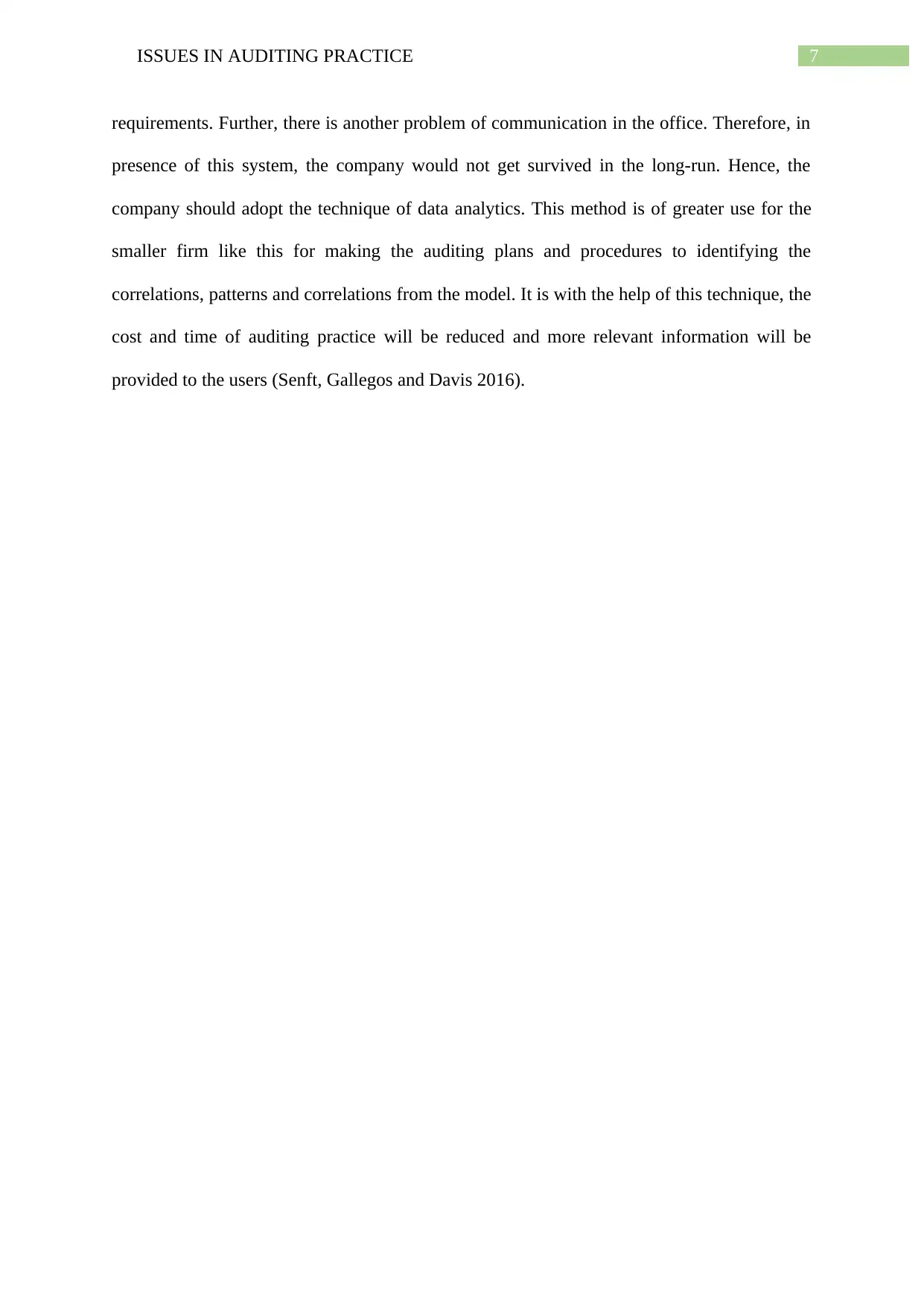
7ISSUES IN AUDITING PRACTICE
requirements. Further, there is another problem of communication in the office. Therefore, in
presence of this system, the company would not get survived in the long-run. Hence, the
company should adopt the technique of data analytics. This method is of greater use for the
smaller firm like this for making the auditing plans and procedures to identifying the
correlations, patterns and correlations from the model. It is with the help of this technique, the
cost and time of auditing practice will be reduced and more relevant information will be
provided to the users (Senft, Gallegos and Davis 2016).
requirements. Further, there is another problem of communication in the office. Therefore, in
presence of this system, the company would not get survived in the long-run. Hence, the
company should adopt the technique of data analytics. This method is of greater use for the
smaller firm like this for making the auditing plans and procedures to identifying the
correlations, patterns and correlations from the model. It is with the help of this technique, the
cost and time of auditing practice will be reduced and more relevant information will be
provided to the users (Senft, Gallegos and Davis 2016).

8ISSUES IN AUDITING PRACTICE
⊘ This is a preview!⊘
Do you want full access?
Subscribe today to unlock all pages.

Trusted by 1+ million students worldwide
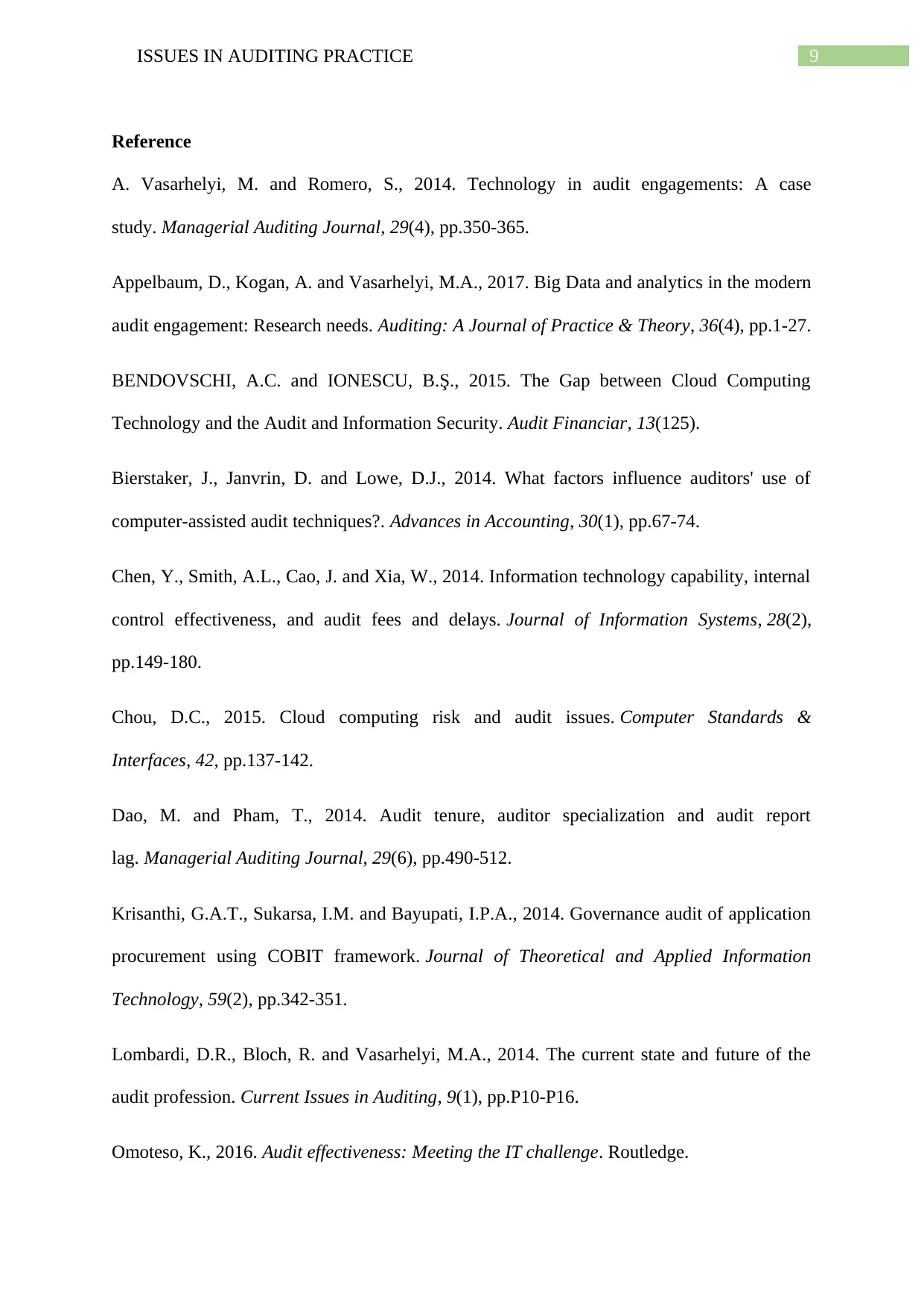
9ISSUES IN AUDITING PRACTICE
Reference
A. Vasarhelyi, M. and Romero, S., 2014. Technology in audit engagements: A case
study. Managerial Auditing Journal, 29(4), pp.350-365.
Appelbaum, D., Kogan, A. and Vasarhelyi, M.A., 2017. Big Data and analytics in the modern
audit engagement: Research needs. Auditing: A Journal of Practice & Theory, 36(4), pp.1-27.
BENDOVSCHI, A.C. and IONESCU, B.Ş., 2015. The Gap between Cloud Computing
Technology and the Audit and Information Security. Audit Financiar, 13(125).
Bierstaker, J., Janvrin, D. and Lowe, D.J., 2014. What factors influence auditors' use of
computer-assisted audit techniques?. Advances in Accounting, 30(1), pp.67-74.
Chen, Y., Smith, A.L., Cao, J. and Xia, W., 2014. Information technology capability, internal
control effectiveness, and audit fees and delays. Journal of Information Systems, 28(2),
pp.149-180.
Chou, D.C., 2015. Cloud computing risk and audit issues. Computer Standards &
Interfaces, 42, pp.137-142.
Dao, M. and Pham, T., 2014. Audit tenure, auditor specialization and audit report
lag. Managerial Auditing Journal, 29(6), pp.490-512.
Krisanthi, G.A.T., Sukarsa, I.M. and Bayupati, I.P.A., 2014. Governance audit of application
procurement using COBIT framework. Journal of Theoretical and Applied Information
Technology, 59(2), pp.342-351.
Lombardi, D.R., Bloch, R. and Vasarhelyi, M.A., 2014. The current state and future of the
audit profession. Current Issues in Auditing, 9(1), pp.P10-P16.
Omoteso, K., 2016. Audit effectiveness: Meeting the IT challenge. Routledge.
Reference
A. Vasarhelyi, M. and Romero, S., 2014. Technology in audit engagements: A case
study. Managerial Auditing Journal, 29(4), pp.350-365.
Appelbaum, D., Kogan, A. and Vasarhelyi, M.A., 2017. Big Data and analytics in the modern
audit engagement: Research needs. Auditing: A Journal of Practice & Theory, 36(4), pp.1-27.
BENDOVSCHI, A.C. and IONESCU, B.Ş., 2015. The Gap between Cloud Computing
Technology and the Audit and Information Security. Audit Financiar, 13(125).
Bierstaker, J., Janvrin, D. and Lowe, D.J., 2014. What factors influence auditors' use of
computer-assisted audit techniques?. Advances in Accounting, 30(1), pp.67-74.
Chen, Y., Smith, A.L., Cao, J. and Xia, W., 2014. Information technology capability, internal
control effectiveness, and audit fees and delays. Journal of Information Systems, 28(2),
pp.149-180.
Chou, D.C., 2015. Cloud computing risk and audit issues. Computer Standards &
Interfaces, 42, pp.137-142.
Dao, M. and Pham, T., 2014. Audit tenure, auditor specialization and audit report
lag. Managerial Auditing Journal, 29(6), pp.490-512.
Krisanthi, G.A.T., Sukarsa, I.M. and Bayupati, I.P.A., 2014. Governance audit of application
procurement using COBIT framework. Journal of Theoretical and Applied Information
Technology, 59(2), pp.342-351.
Lombardi, D.R., Bloch, R. and Vasarhelyi, M.A., 2014. The current state and future of the
audit profession. Current Issues in Auditing, 9(1), pp.P10-P16.
Omoteso, K., 2016. Audit effectiveness: Meeting the IT challenge. Routledge.
Paraphrase This Document
Need a fresh take? Get an instant paraphrase of this document with our AI Paraphraser
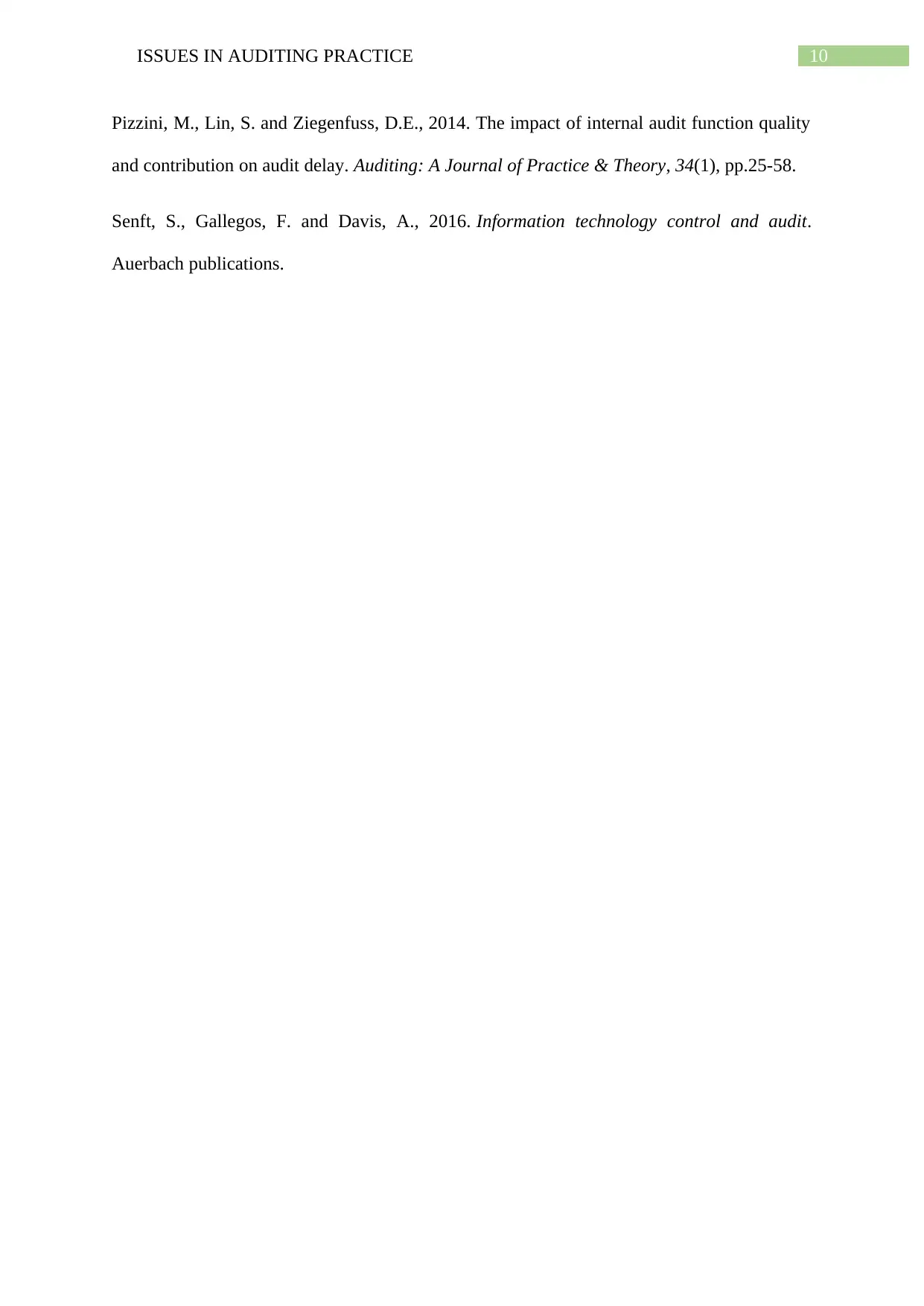
10ISSUES IN AUDITING PRACTICE
Pizzini, M., Lin, S. and Ziegenfuss, D.E., 2014. The impact of internal audit function quality
and contribution on audit delay. Auditing: A Journal of Practice & Theory, 34(1), pp.25-58.
Senft, S., Gallegos, F. and Davis, A., 2016. Information technology control and audit.
Auerbach publications.
Pizzini, M., Lin, S. and Ziegenfuss, D.E., 2014. The impact of internal audit function quality
and contribution on audit delay. Auditing: A Journal of Practice & Theory, 34(1), pp.25-58.
Senft, S., Gallegos, F. and Davis, A., 2016. Information technology control and audit.
Auerbach publications.
1 out of 11
Related Documents
Your All-in-One AI-Powered Toolkit for Academic Success.
+13062052269
info@desklib.com
Available 24*7 on WhatsApp / Email
![[object Object]](/_next/static/media/star-bottom.7253800d.svg)
Unlock your academic potential
Copyright © 2020–2025 A2Z Services. All Rights Reserved. Developed and managed by ZUCOL.





